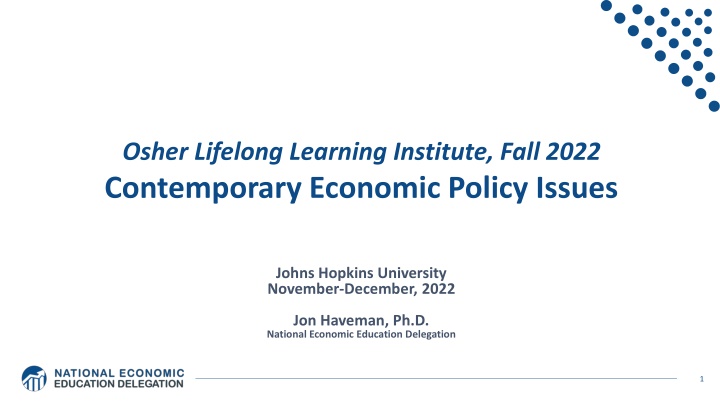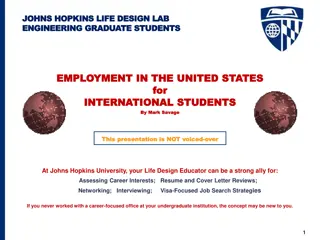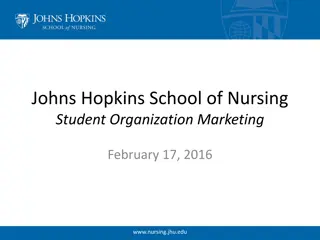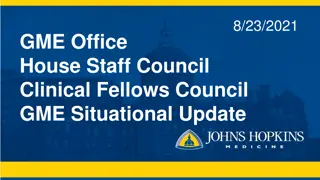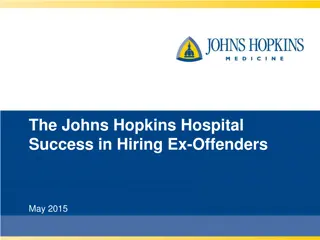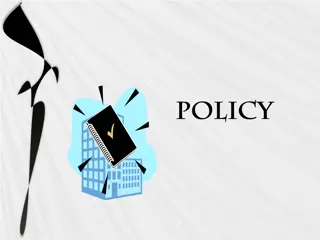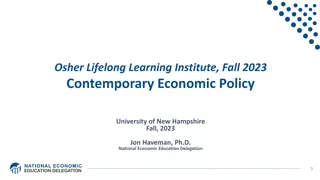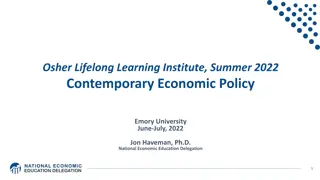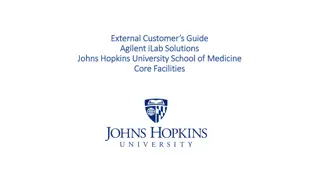Contemporary Economic Policy Issues at Johns Hopkins University
Dive into the Fall 2022 course on Contemporary Economic Policy Issues at Johns Hopkins University led by experts in the field. Explore topics such as the US Economy, Immigration Economics, Healthcare Economics, and more. Gain insights into key economic policies shaping today's world. Join discussions on Economic Inequality, Climate Change, Trade, and Globalization, and other critical issues impacting the economy.
Download Presentation

Please find below an Image/Link to download the presentation.
The content on the website is provided AS IS for your information and personal use only. It may not be sold, licensed, or shared on other websites without obtaining consent from the author.If you encounter any issues during the download, it is possible that the publisher has removed the file from their server.
You are allowed to download the files provided on this website for personal or commercial use, subject to the condition that they are used lawfully. All files are the property of their respective owners.
The content on the website is provided AS IS for your information and personal use only. It may not be sold, licensed, or shared on other websites without obtaining consent from the author.
E N D
Presentation Transcript
Osher Lifelong Learning Institute, Fall 2022 Contemporary Economic Policy Issues Johns Hopkins University November-December, 2022 Jon Haveman, Ph.D. National Economic Education Delegation 1
Available NEED Topics Include: US Economy Immigration Economics Healthcare Economics Housing Policy Climate Change Federal Budgets Economic Inequality Federal Debt Economic Mobility Black-White Wealth Gap Trade and Globalization Autonomous Vehicles Minimum Wages Healthcare Economics 2
Course Outline: Johns Hopkins University Contemporary Economic Policy - Week 1 (11/3): The Black-White Wealth Gap (Jon Haveman, NEED) - Week 2 (11/10): Economic Inequality (Adina Ardelean, Santa Clara Univ.) - Week 3 (11/17): Economics of Immigration (Jennifer Alix-Garcia, Oregon State Univ.) - Week 4 (12/1): U.S. Economic Update (Jon Haveman, NEED) - Week 5 (12/8): Trade and Globalization (Adina Ardelean, Santa Clara Univ.) - Week 6 (12/15): Climate Change Economics (Sarah Jacobson, Williams College) 3
Submitting Questions Please submit questions of clarification in the chat. - I will try to handle them as they come up. We will do a verbal Q&A once the material has been presented. - We can also do 5 minutes of verbal Q&A following the break. Slides will be available from the NEED website soon. (https://needelegation.org/delivered_presentations.php) 4
US Economic Update Jon Haveman, Ph.D. NEED December 1, 2022 5
Credits and Disclaimer This slide deck was authored by: - Jon D. Haveman, NEED - Scott Baier, Clemson University - Geoffrey Woglom, Amherst College (Emeritus) - Brian Dombeck, Lewis & Clark College - Doris Geide-Stevenson, Weber State Disclaimer - NEED presentations are designed to be nonpartisan. - It is, however, inevitable that the presenter will be asked for and will provide their own views. - Such views are those of the presenter and not necessarily those of the National Economic Education Delegation (NEED). 6
Outline About the U.S. Economy Recession The State of the US Economy Global Comparisons Inflation Summary 7
Some Basic Statistics Statistic: Value Population 333.3 Million Labor Force 164.7 Million Employment 153.3 Million Gross Domestic Product (GDP) $25.7 Trillion Income per Capita $65,627 Ave. Hourly Earnings $32.58 8 Source: fred.stlouisfed.org
U.S. Economy in Global Perspective U.S. Nominal GDP: $21.538 trillion in 2019-Q4 $19.637 trillion in 2020-Q2 $25.699 trillion in 2022-Q3 9
Composition of the U.S. Economy: Employment Manufacturing GDP Share = 10.6% Health GDP Share = 7.7% 11 Note: Does not add to 100% because of omitted sectors.
Employment in Baltimore CITY 12 Note: Does not add to 100% because of omitted sectors.
Employment in Baltimore COUNTY 13 Note: Does not add to 100% because of omitted sectors.
Recession(?) 14
Headline: 15
GDP Trajectory: Pandemic Plunge! GDP is: - $0.3 Trillion below 2019 forecast. - $1.0 Trillion ABOVE 2019-Q4 level. 18
What Accounted for the Decline in Q1 & Q2? Expenditures drive GDP growth. - GDP is the sum of four categories of spending: o Consumption o Investment housing/business/inventories o Government spending o Net Exports: Exports Imports 19
Recession? Two Quarters. Depends on what is driving the drop. - Inventories - Housing - Government spending Consumer spending is still ok. Employment growth is solid. Other indicators are still ok. 20
Personal Consumption Expenditures Trouble? 22
Retail Sales 23
Monthly Changes in Nonfarm Employment October: 261,000 September: 315,000 32
Employment Gap 0.8 Million ABOVE February, 2020. 6.2 Million below where we should be. 33
Low Wage Employment is Lagging 37 Source: https://tracktherecovery.org
Wage Growth 38
Where Have All the Workers Gone? 4.0 million below where we should be 40
Some Explanations 500 Thousand: Long COVID Exits 1-2%: Long Social Distancing 41
Inflation 44
Inflation: Latest Figures 45 Source: NYTimes.com
Which Prices? Sep-Oct: +0.4 Aug-Sep: +0.4 July-Aug: 0 June-July: 0 46
Summing Up The US Economy 47 Source: NYTimes.com
Inflation: Not just a US Problem United States: 8.5 Netherlands: Spain: United Kingdom: Denmark: Sweden: Germany: Norway: France: 12.0 10.4 10.1 8.9 8.5 7.9 6.5 5.8 49 Source: TradingEconomics.com, 9/12/22
Import Prices Are Elevated FRED Graph Inflation Imported Products: 9-10% 50
